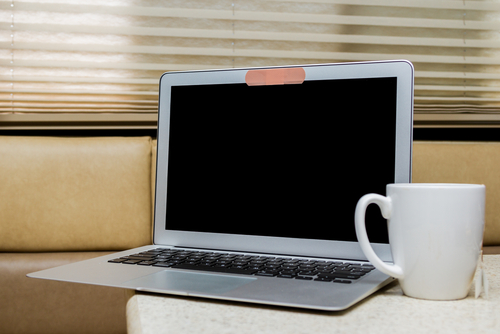How did the webcam progress from a simple convenience to a worldwide security concern in 25 years?
November 2018 can be marked as the 25th anniversary of the webcam. This is a bit of an arbitrary choice, but if we consider a webcam that was installed at the University of Cambridge to keep an eye on the coffee level in the shared coffeemaker as the first one, then it’s been 25 years already. And those 25 years are measured from the moment the images were viewable over the Internet. (The images had been visible on the universities’ intranet since a few years before.)
Definition of a webcam
According to Wikipedia:
A webcam is a video camera that feeds or streams its image in real time to or through a computer to a computer network.
We deviate slightly from this definition by only considering cameras that are visible on the Internet.
The first official webcam
The first camera was actually installed in the late 1980’s so that employees could avoid walking all the way to the coffeemaker to find the pot empty, but it was made visible to the Internet in November 1993. Before that, it could only be seen on the local network. For none other than historic reasons, it is worth mentioning that this camera was in the “Trojan Room” of the Computer Science Department. The scientists used a digital camera with a video capture board and MSRPC2, a remote procedure call mechanism, to upload one frame per second.
The first commercial webcam
The first commercially produced webcam was the QuickCam by Connectix, which was marketed in 1994. It could only be used with an Apple Macintosh and recorded a whopping 15 frames per second. Nowadays, it’s hard to find a laptop that does not have a webcam installed. It has even reached the point where you can buy webcam covers to hide away from prying eyes.

Or use a Band-Aid
Popular usage
The webcam quickly became popular when Internet speeds rose to the level that it was possible to chat face-to-face over long distances. But there are many other legitimate and popular ways to use a webcam:
- Child or pet monitoring: Keep an eye on your loved ones when you are elsewhere.
- Video conferences: Join a meeting that you can’t physically attend.
- Earth cam: Watch the scenery around the world from behind your laptop.
- Security camera or baby monitor: Be alerted when something happens at home or in the baby’s room.
- Porn: Sell your explicit images or video feed to earn some extra cash. (Not that we recommend it…)
- Surveillance: Keep an eye on suspects. (this can also be combined with facial recognition.)
- Vlogging: Share information about your life or interests online via video.
Possible future uses
Some webcam developments are underway, but not quite ready to hit the stores yet:
- Face login: similar to using your fingerprints to log on to a device. Show your face to the webcam, and if it recognizes you, it will let you in. Same as with using fingerprint readers, I’d like the device to ask for my secret password now and then—just in case a thief looks a bit like me. Windows already has Hello Face Authentication, but it requires near infrared imaging.
- VR-like webcams: adding an extra dimension to your webcam, 3D could make your online chats even more realistic. 3D webcams are already available, but the technology to use it in person-to-person chat isn’t available yet.
Internet of Things concerns
The Internet of Things (IoT) has been a subject of our cybersecurity related concerns before, and we don’t expect those concerns to go away anytime soon. Webcams are among the top IoT problems because of their sheer numbers and their often weak security setup, such as easy-to-guess and hard-to-change default passwords.
If you want to be freaked out a little, here are some of the websites that let you take a peek through the eye of unprotected webcams:
Botnets
A botnet is a collection of centrally controlled devices and systems that accept commands from a remote administration. IoT devices, including webcams, are the stuff that the currently most powerful botnets are made of. The Mirai botnet, for example, has been responsible for some of the most effective DDoS attacks. Working for a central command has also made it possible for IoT botnets to be used in cryptomining.
Facial recognition
Facial recognition works by measuring distances between features on a face and comparing the resulting “faceprint” to a database. To get a dependable recognition rate, the tech must measure around 80 nodal points on the human face to create a faceprint and find a match.
Big Brother
The combination of publicly available security and surveillance cameras has brought Orwell’s vision of blanket surveillance to life. China is already using its massive network of closed-circuit television (CCTV) cameras and facial recognition technology to track its citizens. And if naming and shaming jaywalkers is the only activity they admit to, you can rest assured that it is far from the only thing that they are keeping track of.
Camfecting
Camfecting is a term used for hacking into a webcam’s data stream. Threat actors would be able to view or store the live feed from a webcam for their own purposes. An important thing to keep in mind is that if they have hacked your webcam, they are just as easily capable of turning off any warning light that would show you whether it’s active or not. The fear of camfecting is one reason for webcam covers (or post-it notes, Band-Aids, and other sticky stuff to cover the webcam’s eye). Stolen video images can lead to sextortion and other extortion practices.
Historic overview
Looking back, in 25 years we went from watching the level of supply in a coffeepot online to the state surveillance capabilities where we can be found and identified in a matter of minutes. And where we can’t be sure who is watching us or what the devices, we are using to look at others, are doing in the background. Are they sending the same images to the manufacturer? Or to some hacker? Should we be worried about those sextortion emails? Probably not, but that still leaves us with lots of other things to worry about.
Different types
Webcams come in many different types, shapes, and sizes. While they perform many useful and convenient tasks, we need to be aware of the dangers and concerns that come with using them. The ones that we should be worried about most are the ones that are connected directly to the internet. The ones that are connected or even built into our computers and laptops are under control by the active security solutions. The IoT devices however, especially the ones that are fitted with no or default credentials, are a major concern in the fields of privacy and cybersecurity.
Use webcams to connect with friends and family, for meetings, and to keep an eye on your inventory, but don’t allow them to be the weak link in your home or business network.











